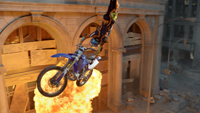
The Super Bowl’s 2012 broadcast featured fantastic TVCs that competed with gridiron action for
attention. The Mill, ATTIK, Method Studios and MPC talk about their VFX and animation work on
spots surrounding the big game.
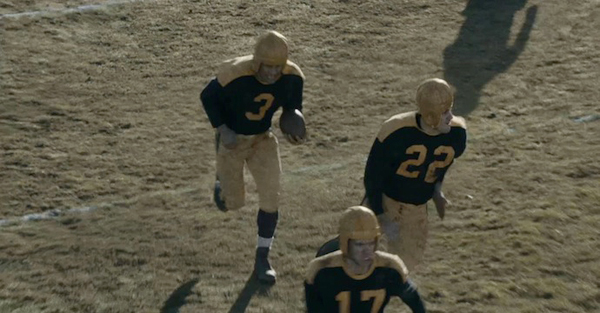 |
|
| NFL ‘Timeline’ – The Mill Directed by Peter Berg, ‘Timeline’ is a trip through time and several different stadiums, from football in the early 1900s through the present day. With players' health and safety the main concern, the NFL wanted to raise awareness about changing rules and regulations over the years. Most of The Mill's work on this spot came in the form of populating the stadiums using Massive software. Wyatt Savarese, Co-Lead 3D Artist said, "We had to build over 20 different Massive agents from scratch, and each agent had to reflect the time period they were in." For instance, in the beginning of the spot most of the men are wearing fedoras and period clothing. As the film progresses, hints of the home team's colours are seen trickling through the crowd, and by the late '80s to present day the crowd is in full, home-team costume. Co-Lead 3D Artist Ruben Vandebroek said, "Since our goal was to make the stadiums and crowds for each decade look as authentic as possible, we spent a lot of time looking through NFL archival footage and pictures to figure out what the stadiums looked like in each era. Since the early decades of play were shot on a field in Los Angeles and the latter were shot at the LA Memorial Coliseum, we had to replace the existing fields with the appropriate stadium for each team and decade." Famous stadiums such as Lambeau Field, Old Mile High Stadium and Soldier Field were completely rebuilt in CG. |
|
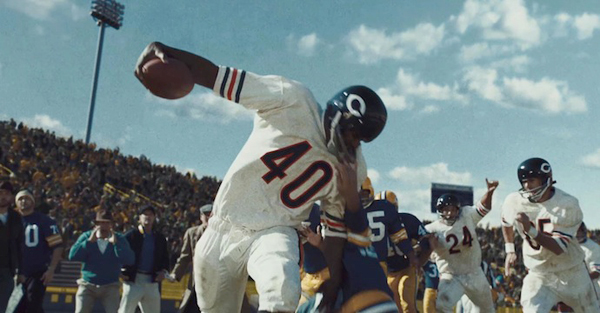 |
|
| Wyatt explained that the modelling team worked on over one hundred different jackets, shirts, hats and other fan gear. “All of this geometry was fed into Massive and set up into variables so the end product was a much more natural looking crowd,” he said. “As the spot progresses, you see much more variety in the colour and clothing of the agents. All of the clothing was researched so that we could make it fit the time period. We used fashion history books and catalogues for the early decades, and for the latter part of the spot we had near unlimited access to the NFL archives. Over the years the Mill has accumulated a huge motion capture/agent library, and we used it extensively for this job.”
The transitions came together through careful collaboration among all parties. The director Peter Berg was very involved with The Mill’s pre-viz and was able to set up all the shots so that the physical transitions where much easier to link together. After the shoot, the editor Damion Clayton of Rock Paper Scissors worked alongside the agency and The Mill. |
|
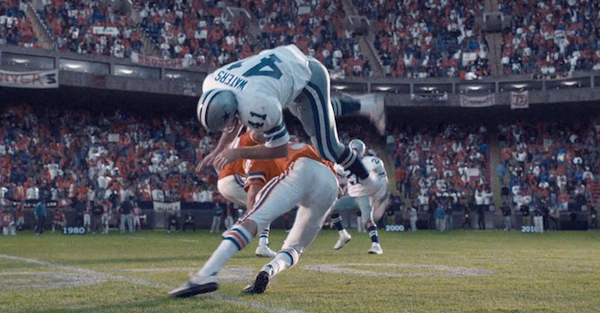 |
|
| Wyatt also described work on the playing fields and stadiums. “To build the older stadiums like City Stadium in Green Bay, we were able to use archived photos from the NFL. For the Denver Broncos Stadium in the ‘70s, we did a bit of ‘kit bashing’ - using the Stadium model library at The Mill, we were able to take bits and pieces of existing stadium models and make an ‘old’ Mile High stadium.
“Solider Field however was our hero stadium. The Mill sent a VFX supervisor to an actual Bears game at Solider Field. The first day of the shoot was during the game so we could see and feel the vibe of the stadium. On the second day, the NFL and the Bears organization gave us unrestricted access to the empty stadium so that we could take reference photos of everything. Once we had the photos on the server, the Mill was able to model the field accurately. “The problem with doing a full CG background replacement is lack of proper tracking info. For this particular project, we were lucky enough to shoot at a real stadium, the LA Coliseum. This gave us plenty of tracking info and relatively close proportions to the stadiums we were replacing. After the footage was tracked, it was just a matter of getting the correct scale of the CG stadiums. Working with the physically correct stadiums made this easy.” |
|
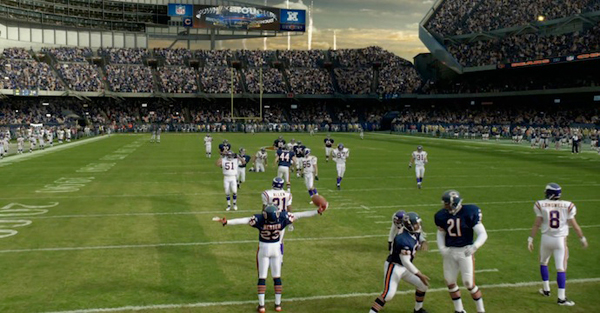 |
|
| In order to retain the authenticity of each decade, Senior Telecine Artist Fergus McCall collaborated with Lead 2D and Flame artist Westley Sarokin, the agency GREY NY and the NFL clients. “The colour grading was done in tandem with the visual effects,” Westley said. “As the composites evolved, the grade and look would be addressed and balanced. Because the look of the footage was such an integral part of the story, it was something we tweaked till the last day as the final version of the shots came together.”
"The colour correction was done over five or six sessions on the Baselight 8, starting with a technical grade and then growing in scale and complexity as the VFX were bedded in. The workflow remained 10 bit log dpx till final delivery," explained Fergus. "The aim with 'Timeline' was to create a visually interesting piece that, like the epic play itself, moved through the years seamlessly without interfering with the story. "Various pieces of archive footage provided by the NFL had to bed in with our live action, which was all shot on the ARRI Alexa. This provided quite a challenge." Extensive use of adapted 3D LUTs and multi layered colour corrected passes, which the Baselight handled quite easily, allowed the colour VFX to be executed quickly, work that would previously have taken days to combine in Flame. According to Westley, the Alexa footage was a benefit. “It's always tricky to try to create and match the look of old film stocks from pristine modern footage, but we found that the Alexa images gave us plenty of latitude to experiment and find the right visual aesthetic for each era.” “Over the last couple of years we’ve become more focused on the integration of the 2D/3D and colour workflow. Tapeless, file-based pipeline and integrated, compatible operating systems now mean we can work this way without major bottlenecks. This might sound surprising coming from The Mill, a company that has always believed that the best work is produced by creatively-minded people working collectively, rather than independently of each other,” said Fergus. “In reality, though, these technologies and tools have only allowed this kind of flexibility over the past few years. While the feature film workflow has broadly worked in a nonlinear way for over 10 years, advertising has had to stick to a more rigid, linear pipeline, something that is thankfully beginning to break down. “NFL Timeline is a great example of this change. With so many visual effects to create over the course of five weeks, it made no sense to set a definitive look at the beginning of the process, as would traditionally have been done. The look emerged as the layers of VFX were created, effectively merging into the VFX process as it evolved. Initially, we had considered a number of different looks for the changing eras, but not one of those original colour corrects actually made it into the final version. Because all post was done on a technical grade, nothing was baked into the film so it was easy to adapt everything as the job progressed. “With any VFX heavy job there is absolutely no reason to set a look and be stuck with it for the duration of the project. If all work is to be completed in house then it makes a job both rewarding and efficient to move between 2D, 3D and colour in a fluid, flexible way through the project and use the synergy among all three departments. When the opportunity to work in this way comes along, our in-house teams and clients enjoy it and the benefit is evident in the result.” www.themill.com |
|
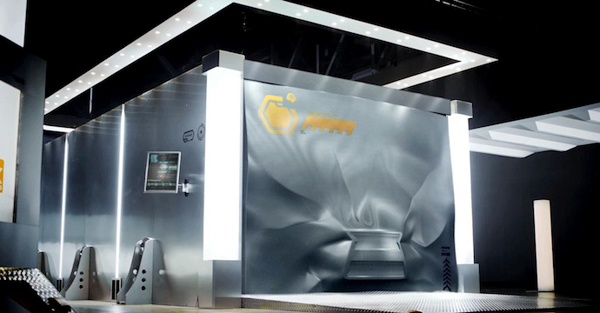 |
|
| Lexus ‘The Beast’ – ATTIK & The Mill Director Simon Needham, Co-Founder and Executive Creative Director at ATTIK, said that in ‘The Beast’, the client had a new direction and a new car, the Lexus GS, to introduce and wanted to use the Super Bowl to attract attention to their new message, ‘Change cannot be contained’. “We shot on Alexa cameras so that we could shoot digitally and get a great, filmic look. We used the Russian Arm, a tripod and mounted the camera on the side of the moving car at wheel level, and inside the car,” said Simon. Across the production, ATTIK approached companies with film experience because the client wanted a big, cinematic commercial that could run in both the Super Bowl and the cinema. The Mill, engaged for visual effects, had experience with feature work as well as large, cinematic spots, and provided input on the plates the crew planned to shoot and what to consider when shooting to help the effects blend invisibly into the live action. The Mill also helped with the bid to decide what had to be shot practically and what could be created in post. ATTIK led with a variety of references to create the tension and suspense in the spot. “The references first gave the client an idea of how ATTIK wanted to approach the spots,” said Simon. “Those same references then enabled the production, post, visual effects and music companies to envision the scope of the project. Cinematic references focused on impending doom with increasing frequency of boom sounds with environmental repercussions. Some shook the environment or showed objects exploding in slow motion to see how they react in an explosion, or when a car bursts through walls.” The Mill’s team created a dynamic CG metal-on-metal dent, explosion and particles, and added CG set extensions and obstacles for the Lexus GS to weave around. Tracking was their biggest challenge, mainly because of camera speed and varying angles. Nevertheless, ‘The Beast’ was a rewarding creative project and for VFX Supervisor/Lead 3D Artist at The Mill, John Leoni, working with the agency and director turned out to be a very collaborative experience. He said, “This is always the best situation to work under because we can get what we need for post to make the VFX work and the director and agency achieve their vision of the spot. We took care of the technical challenges and allowed the director to direct the spot and look at it from a creative point of view. As it turned out, Simon has an incredible eye for detail, which helped immensely creatively.” John said that the most important data to have from set was lighting reference, for which they captured HDR images and shot chrome and grey ball reference. “Almost all the lighting was practical. Even the reflections from the bright lights on the CG boxes in the background were practical lights placed in the correct place on set. When on set we always try to shoot things for real if it’s possible and then take care of the impossible. “The lighting data also helped deal with the reflective, metallic environment. It did mean longer renders because of the calculations that go into reflective environments and surfaces, but it’s something that we deal with on a daily basis. We always do a set survey as well to help us track shots that need CG added to them and we always get camera data like lens height and tilt.” |
|
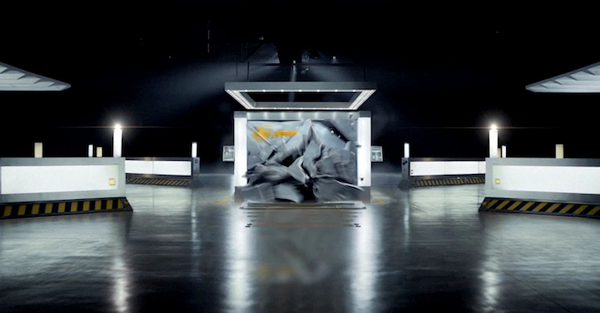 |
|
| The Mill’s film reference was Stephen Spielbergs’ ‘Super 8’ particularly when the creature breaks out of the crashed train carriage. Generally the idea was to give a very cinematic feel to the lighting and compositing. The opening shot descends from the earth’s stratosphere down to a shaking water cooler in the laboratory. “For this shot to work, we had to stitch together the footage of the earth and the shot from set. Both of these were travelling at different speeds so it was a fair bit of 2D work to get them to marry together and still have the timing work for the pacing of the spot,” said John.
ATTIK’s Senior Producer Michele Morris said, “The two biggest looks to work out were the dent and the explosion. The dent had to convey the shape of the new grille and the metal had to crumple realistically. The Mill did CGI and physical tests, carving a grille out of wood and physically denting a piece of metal. Some of the physical aspects of the dents were then incorporated into the CG. John described their method. “We tried a few techniques to get this looking correct. One was to use a cloth simulation with the properties of metal punched in to the cloth solver. But ultimately we ended up modelling the dent from the reference we created using tin sheets and a form in the shape of the car grille. This really gave us the minute control we needed.” The explosion had to look like a car bursting out of the door of the box, not caused by fire or combustible elements. Josh Hatton, 3D Artist at The Mill, said, “The entire shattering effect was done using SideFX Houdini, using a combination of modeling tools, rigid body dynamics, fluid simulations and particles. Its shatter toolkit allowed us a huge amount of flexibility when designing the look of the shards. We could literally move a slider to vary the number, size and shape of the pieces. “The beauty of this is that once the initial dynamics setup was complete, if we changed the shard pieces, we didn't need to recreate the whole setup. Everything just worked. Because of the procedural nature of Houdini, the main rigid body simulation for realistic bouncing and collision of solid objects, drove all the other elements, which included debris - geometry instanced on particles, dust - high resolution fluid simulations, and tiny splinters that sparkled in the air for texture - point particles. The trick was to keep it clean in feeling, but there are actually a lot of subtle elements to give it realism.” Considerable work was done first to determine the correct trajectory, and then the size and shape of the pieces to ensure they were interesting to watch, believable and had forward and sideward trajectory paths that preceded the car but didn’t land on it. “The pieces also had to look like the door, five inches thick with a brushed metal exterior, then a layer of wood and egg-crate foam lining. Many films of actual explosions, flying debris and cars driving through and bursting out of houses were referenced,” said Michele. The spots called for one hero foreground box and four background boxes. In the Super Bowl version, the boxes are kept in the dark until the reveal at the end. In the cinema spot, the boxes are seen from the beginning. John advised only shooting one background box and creating the other three in post, and placing lights where the boxes would be to provide natural light spill in the environment. The hero box would need removable front and back doors, so it could be shot with doors for the dent shot and all shots before the explosion, and then without doors for the explosion allowing them to use a real car, not CG, to exit the box. “We shot two plates. One was the camera move with the real flat panel in place and once without the panel. This gave us perfect reference of how the light moved across this surface when the camera moved,” said John. Michele said, “A lot of set extension was required in the tunnel the car drives through, which was created in a parking garage, and the walls were extended upwards with pillars created to make it look like a real tunnel. The Mill helped determine how high to build the walls. Closing CGI doors were created to build tension as the car escapes the lab.” John indicated that the tracking on this job was some of the trickiest he has done for some time. “The main reason was that it was shot on a Russian arm, which is basically a camera on the end of a crane mounted on top of a moving car! This creates a lot of very fast movement in every axis, which blurs your set where your tracking markers were positioned. Also because you are shooting the car, it takes up 80 per cent of your frame, further obliterating the set and tracking markers. “To work around this we used a couple of 'tricks'. One was to track the car itself, as an object track, and work out where the background should be. In other instances we ended up building a fill set and projecting the plate back on to make everything stick. Our last trick was old school eyeball tracking and moving the camera for every frame. We were using PFTrack, 3DEqualiser, Boujou - and our own eyes.” www.attik.com www.themill.com |
|
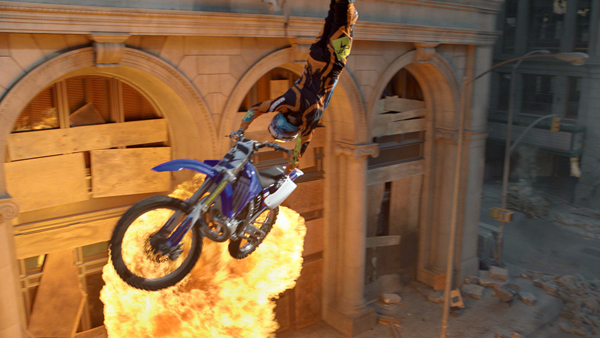 |
|
| Time Warner Cable ‘Enjoy Better Anthem’ - Method Seven commercial projects kept Method Studios’ teams in LA, New York and Australia busy leading up to the 2012 Super Bowl. Three of them were VFX-heavy spots directed by Noam Murro at Biscuit Filmworks. ‘Enjoy Better Anthem’ for Time Warner Cable through agency Ogilvy & Mather, was led by Method’s New York team with help from colleagues in Sydney. The spot stars Ricky Gervais and promotes premium entertainment channels and cross-platform media portals as the story follows a progression of high-action stunts, created with a great variety of techniques. Doug Luka, VFX Supervisor said, “We had a lot to do in a very short period of time but Noam and the Biscuit team made sure we had everything we needed in order to pull this spot together. At Method, we created CG Blackhawk helicopters and pulled out all the stops with matte paintings, layered explosions and atmospheric effects to make the back-lot sets feel rich and cinematic, matching the director’s vision.” Doug and Sydney’s VFX Supervisor James Rogers said that previs was tremendously helpful for this ad to determine how to shoot and how many shots would require CG. It also helped with the transitions, which the agency had worked out in advance. The spot comprises a roughly equal combination of back lot and location shots captured on the streets of Los Angeles. The opening shot’s city street transforms into a war zone scene scattered with rubble, soldiers and tanks and explosions. “We added explosions, debris, smoke,” said Doug. “For all of the buildings, we tried to get rid of the back lot feel by adding cracks, broken windows and other evidence of destruction. We did this by integrating matte painting and utilizing textures and compositing in Nuke. Using 2D plates of smoke, explosions and richocheting shrapnel, we stripped in layer after layer to create a rich textural backdrop that simulated a war zone. When we got closer to transitions, we started to strip the layers back to create the seamless movement into the next vignette.” Although a wide variety of explosions carries on, from small and smoky to a huge cloud of fire, all of these were 2D element plates composited in Nuke and Flame. Likewise a daring team of stunt bikers were all captured in-camera. The spot’s colourist Tim Masick from Company 3 was able to help with continuity in light as well as colour between scenarios. “For a shot at a florist’s shop, for example, the interiors were shot at Silvercup Studios in New York and the exteriors were shot on location in LA. Matching up those scenes required both rotoscoping and colour correction in the Flame.” The team also created matte paintings to help change the looks of environments. For the exterior of flower shop, matte paintings were used for ivy on the walls, and the war zone featured matte painted broken windows and cracks in the buildings. The spot often involves very extreme camera angles, and many are shot from overhead or from ground level which created a need for sky replacements to achieve continuity. Method went through a complete CG modelling, texturing and animating process for the Blackhawk helicopters using Maya, Renderman, Nuke and Flame. “When the Blackhawks strafe Ricky as he runs from a horde of zombies, our 3D team added not only the digital helicopters but also flying rubbish, dust, leaves and other chaos. We also used a double and stitched on the back of Ricky’s head for these shots. It’s the kind of outrageous fun Super Bowl spots are known for!” Doug said. At times, Ricky was shot on green screen. Whenever we see him in scenes with a crowd of Zombies, for example, he has actually been shot the day before on green screen. Atmospherics play a role in tying the scenes together and drawing viewers’ eyes into the background. For some shots, Maya fluid simulations were used or, for the debris at the end, live action elements composited in flame, but most everything else was achieved using plates of elements. Throughout the spot, Boujou, 3D Equalizer and Silhouette were all used for tracking. www.methodstudios.com |
|
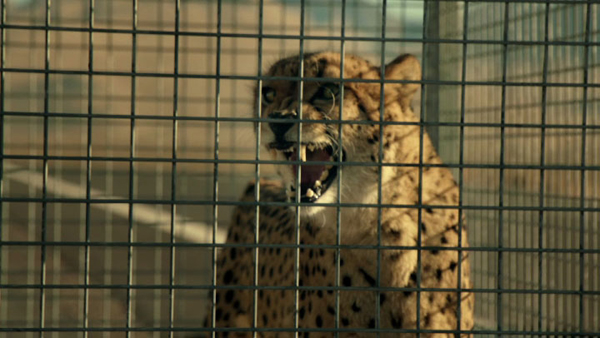 |
|
| Hyundai ‘Cheetah’ - MPC Two Super Bowl Hyundai spots featured VFX by MPC, one of which starred a photorealistic cheetah racing a Veloster sports car. As MPC’s Producer on the project, John Attard gives his view of the collaboration between the team, agency Innocean and Rattling Stick Director Daniel Kleinman on ‘Cheetah’. The spot opens as a Veloster and a caged cheetah square off at the starting line of a desert airstrip. The race begins with a roar as the cat's handler flings the cage door open, but it only takes a second for the cheetah to realize he's in an unwinnable race and turn his aggression on his handler. MPC created the photo-real cheetah by photographing a real one on set and capturing high dynamic range images of the lighting conditions, then combining both of those elements in Furtility, the facility’s in-house fur-and-hair tool. To test the success of their project, the team produced an image with three cheetahs and asked in-house artists and producers to identify the real one. On all but one case, they missed. |
|
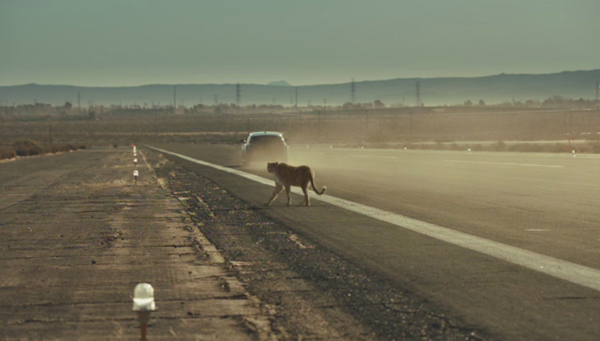 |
|
| “The most important direction we received regarding the cheetah from the agency and the director was to make it look real,” said John. “Initially we were trying to get many of the shots that we created in-camera, but Tango the cheetah refused to cooperate on set. From the prep of the commercial we were interacting with Tango and taking pictures so that he wouldn’t only look real, but look like Tango. We knew that in the desert, harsh lighting would be something we really needed to pull off accurately. We did numerous tests with our Maya-Furtility pipeline and pre comps in Nuke to establish the layers we had to generate to gain maximum control in the final composite.”
During preproduction, MPC focused on creating the cheetah, producing animation cycles to match Tango’s behaviour in the spot, continuing to work on his shader in Furtility and creating the composite strategy for Nuke and Flame. Detailed storyboards were prepared for the shoot and the team provided animatics of the cheetah’s action during the editorial stage. “We needed a lot of survey and lens information. Due to the large distances the cheetah would cover, it was important to have correct scale and lens information for each shot,” John said. The harsh lighting, from a single direction, had to be matched perfectly. John said, “As part of the shooting process we walked Tango through the scene in the position that he would be in for the final shot. Getting the hair absolutely correct in those lighting conditions was difficult. We produced numerous test stills that included both our CG representation of the cheetah with numerous variations, and the real cheetah.” The cheetah was tracked into the shots with PFTrack, and the project was rendered in Renderman with Alfred, finished in Smoke. |
|
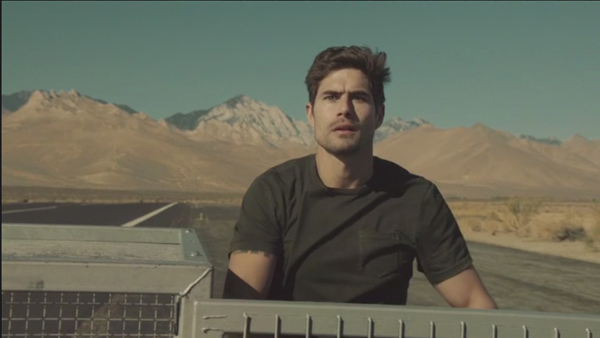 |
|
| “The R&D team works on several photo-real creature projects at any one time. The experience gained from them is invaluable because software such as Furtility is in constant evolution based on its use in projects. We freeze versioning once we open a project, through to its completion, but afterwards the software moves forward considerably.
To capture and refine the animation, as important as the light to give the cheetah its realism, the animators looked through hours and hours of reference footage and took time to learn just how the animal moves. John said, though, that it’s not enough to watch a video and mimic the motion on display. “You really need to understand how the animal moves and behaves, and reflect this in the animation rig, which allows a performance designed specifically for that creature. Some of MPC’s creature-specific animation tools were used for rigging and muscle animation in addition to Furtility.” Creating their photorealistic cheetah was the main focus of their efforts, but considerable invisible work was also necessary to produce a sharp looking commercial. They shot on an airstrip in the desert, but had to paint out many of the buildings, vehicles and people that were present in the plates in order to represent the private location in the final spot. The usual tasks, for example removing reflections of crew and camera from the car were carried out and in one particular moving shot they also extended the runway out into the distance. www.moving-picture.com |
|


















